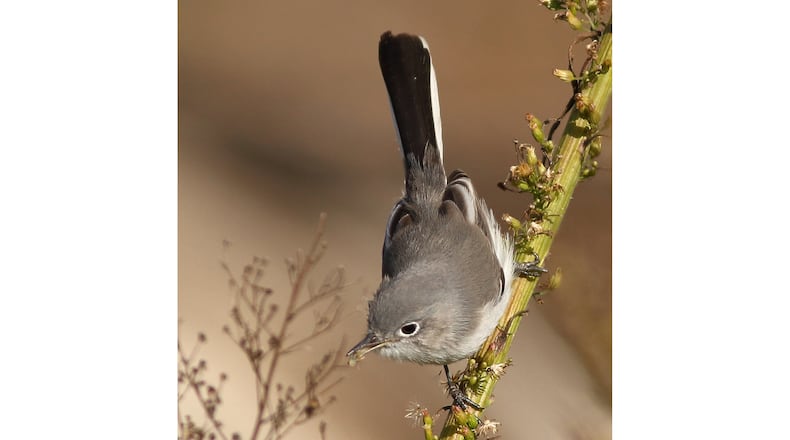Walking along a path in a DeKalb County park the other day, I noticed what seemed to be a commotion at a tent caterpillar web attached to a black cherry tree — a couple of energetic little birds were tugging at the “tent’s” silk webbing.
I knew immediately that they were a breeding pair of blue-gray gnatcatchers gathering the silky material for their nest. The birds’ minuscule size and color patterns — which resemble a mockingbird’s — gave them away. At about 4.5 inches long, the gnatcatcher is one of Georgia’s tiniest birds, only about a half inch to an inch longer than the ruby-throated hummingbird, the state’s smallest species.
The gnatcatcher’s cup-shaped nest also is remarkably similar to the ruby-throat’s, although the gnatcatcher’s is about an inch larger. Like the ruby-throat, gnatcatchers build their nests on outer branches of hardwood trees from small plant matter, hair, feathers and other soft material. Silk from spiders and tent caterpillars is used to weave the material together. The nests’ exteriors are covered with lichens that provide near-perfect camouflage.
But unlike the male ruby-throated hummingbird, which abandons the female as soon as he impregnates her, the male gnatcatcher is a devoted father. He not only helps the female build the nest, but helps incubate the four to five eggs that she lays and then assists her in feeding the babies that hatch in about two weeks and fledge 10-12 days later.
As its name implies, the blue-gray gnatcatcher eats gnats, but it also consumes a variety of other small insects and tiny invertebrates. It’s a bane to spiders: Not only does it snatch their silky webs, but it also grabs any insects trapped in the webs and may eat the spider as well. The little bird’s strict invertebrate diet and its tendency to stick to its forest habitat make it unlikely to show up at backyard bird feeders.
In late summer, many gnatcatchers will migrate to Latin America for the winter; some, however, will go no farther than South Georgia.
IN THE SKY: From David Dundee, Tellus Science Museum astronomer: A total lunar eclipse of the full moon will occur on Sunday, starting at 10:27 p.m. It will be fully eclipsed by 12:11 a.m. and end Monday at 1:55 a.m. The Cherokee people called this month’s full moon the “Planting Moon.” Venus, Mars, Jupiter and Saturn (rising just after midnight) are all low in the east a few hours before sunrise.
Charles Seabrook can be reached at charles.seabrook@yahoo.com.
About the Author
Keep Reading
The Latest
Featured


